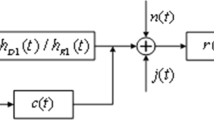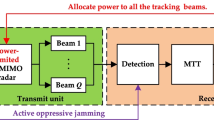Abstract
The improvements of anti-jamming performance of modern radar seeker are great threats to military targets. To protect the target from detection and estimation, the novel signal-to-interference-plus-noise ratio (SINR)-based and mutual information (MI)-based jamming design techniques were proposed. To interfere with the target detection, the jamming was designed to minimize the SINR of the radar seeker. To impair the estimation performance, the mutual information between the radar echo and the random target impulse response was used as the criterion. The spectral of optimal jamming under the two criteria were achieved with the power constraints. Simulation results show the effectiveness of the jamming techniques. SINR and MI of the SINR-based jamming, the MI-based jamming as well as the predefined jamming under the same power constraints were compared. Furthermore, the probability of detection and minimum mean-square error (MMSE) were also utilized to validate the jamming performance. Under the jamming power constraint of 1 W, the relative decrease of the probability of detection using SINR-based optimal jamming is about 47%, and the relative increase of MMSE using MI-based optimal jamming is about 8%. Besides, two useful jamming design principles are concluded which can be used in limited jamming power situations.
Similar content being viewed by others
References
KAY S M. Optimal signal design for detection of Gaussian point targets in stationary Gaussian clutter/reverberation [J]. IEEE Journal of Selected Topics in Signal Processing, 2007, 1(1):31–41.
ROMERO R A, BAE J, GOODMAN N A. Theory and application of SNR and mutual information matched illumination waveforms [J]. IEEE Transactions on Aerospace and Electronic Systems, 2011, 47(2):912–927.
GARREN D A, OSBORN M K, ODOM A C, GOLDSTEIN J S, PILLAI S U, GUERCI J R. Optimal transmission pulse shape for detection and identification with uncertain target aspect [C]// Proceedings of the 2001 IEEE Radar Conference. Atlanta: IEEE, 2001:123–128.
COVER T M, THOMAS J A. Elements of information theory [M]. Hoboken, NJ: Wiley, 1991, 12–21:253–256.
LEE S H, LEE S M, SOHN G Y, KIM J Y. Fuzzy entropy design for non convex fuzzy set and application to mutual information [J]. Journal of Central South University of Technology, 2011, 18(1):184–189.
TAN C C, SHANMUGAM S A, MANN K A L. Medical image registration by maximizing mutual information based on combination of intensity and gradient information [C]// 2012 International Conference on Biomedical Engineering (ICoBE). Malaysia, 2012:368–372.
WOODWARD P M. Information theory and the design of radar receivers [J]. Proceedings of the IRE, 1951, 39(12):1521–1524.
WOODWARD P M. Probability and information theory, with applications to radar [M]. New York: Pergamon Press, 1953:100–112.
WOODWARD P M, DAVIES I L. A theory of radar information [J]. Philosophical Magazine, 1950, 41(321):1001–1017.
BELL M R. Information theory and radar: Mutual information and the design and analysis of radar waveforms and systems [D]. Pasadena, California, USA: California Institute of Technology, 1988.
BELL M R. Information theory and radar waveform design [J]. IEEE Transactions on Information Theory, 1993, 39(5):1578–1597.
LESHEM A, NAPARSTEK O, NEHORAI A. Information theoretic adaptive radar waveform design for multiple extended targets [J]. IEEE Journal of Selected Topics in Signal Process, 2007, 1(1):42–55.
ROMERO R A, GOODMAN N A. Information-theoretic matched waveform in signal dependent interference [C]// Proceedings of the 2008 IEEE Radar Conference. Rome, Italy: IEEE, 2008: 1–6.
YANG Y, BLUM R S. Radar waveform design using minimum mean-square error and mutual information [C]// Fourth IEEE Workshop on Sensor Array and Multichannel Processing. China: IEEE, 2006:234–238.
GUO Dong-ning, SHAMAI S, VERDU S. Mutual information and MMSE in Gaussian channels [C]// IEEE International Symposium on Information Theory Proceedings. Chicago: IEEE, 2004:349–349.
ZHANG Wen-shu, YANG Liu-qing. Communications-inspired sensing: a case study on waveform design [J]. IEEE Transactions on Signal Processing, 2010, 58(2):792–803.
KAY S M. Fundamentals of statistical signal processing: Detection theory [M]. New Jersey: Prentice Hall PTR, 1998:105–110.
KAY S M. Fundamentals of statistical signal processing: Estimation theory [M]. New Jersey: Prentice Hall PTR, 1998:389–391.
Author information
Authors and Affiliations
Corresponding author
Additional information
Foundation item: Project(61171133) supported by the National Natural Science Foundation of China; Project(11JJ1010) supported by the Natural Science Fund for Distinguished Young Scholars of Hunan Province, China
Rights and permissions
About this article
Cite this article
Wang, Ll., Wang, Hq., Cheng, Yq. et al. A novel SINR and mutual information based radar jamming technique. J. Cent. South Univ. 20, 3471–3480 (2013). https://doi.org/10.1007/s11771-013-1871-6
Received:
Accepted:
Published:
Issue Date:
DOI: https://doi.org/10.1007/s11771-013-1871-6




